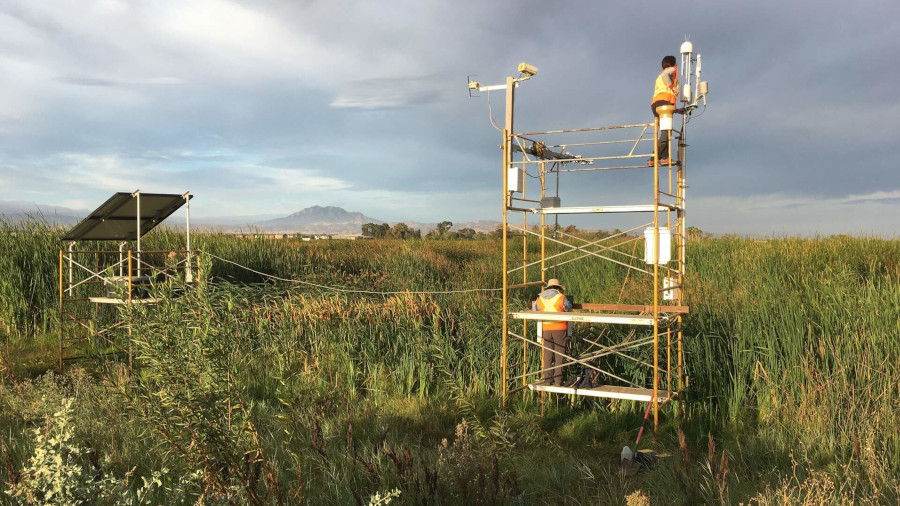Improved predictions of methane gas emissions in tidal wetlands
An International study led by UAB researcher Ariane Arias-Ortiz, and published in Global Change Biology, has analysed methane gas fluxes in over a hundred tidal wetlands and marshes in the USA. The analysis has identified key environmental factors affecting methane emissions and has allowed a larger set of standardised data on greenhouse gas emissions in those ecosystems to be produced. These data can be used to account for greenhouse gases with greater precision and improve climate models.

Tidal wetlands are extremely important environmentally, not only for the role of their ecosystems in conserving biodiversity, or the protection of erosion and promotions of fishing activity, but also because they contribute to the elimination of carbon dioxide from the atmosphere and slow down the decomposition of organic material in soils which are humid and poor in oxygen.
However, these conditions also promote the release of methane, a greenhouse gas that is significantly more powerful than carbon dioxide and have more potential to trap heat in the atmosphere. The effect of methane emissions counteract the effect of carbon dioxide sequestration so determining and predicting methane gas emissions in tidal wetlands with precision is essential for assessing the climate implications of the restoration or degradation of these natural environments.
A study led by a Ariane Arias-Ortiz of the UAB Department of Physics, and member of the Marine and Environmental Biogeosciences research group of ICTA-UAB, has analysed the data for methane fluxes in 109 tidal wetlands in the USA, focussing on factors such as climate, vegetation and the chemical composition of water trapped in the sediment. This is the first time that a such a large set o data on these emissions, together with a broad range of environmental and biogeochemical parameters has been made available to the entire scientific community in a standardised manner.
The research has identified important spatial and temporal predictors in the methane emissions which have interactive effects among the environmental variables documented for the first time. It was observed that salinity is a dominant factor: the more saline wetlands emitted low levels of methane while more freshwater marshes presented variable emissions. In the freshwater marshes, the warmer ones emitted more methane while in wetlands situated above the flood plain (less flooded) emitted less.
The study also showed that seasonal variations in methane emissions in the same ecosystem depend to a large extent on temperature—the higher the temperature the greater the level of emission—and the fixation of plant carbon and photosynthesis. Unlike inland wetlands, the tidal marshes show significant variation in methane emission on a daily basis, influenced by plant activity which can improve root exudation during active photosynthesis, stimulating methane-producing microbes or facilitating their transport through cavities in the plant tissue. Additionally, in zones with significant tidal activity the highest level emissions are produced as intermittent releases of stored gas after every low tide. Using data from the study we the models for predicting and facilitating the simulation of methane gas in tidal wetlands in a changing climate can be improved.
“Methane emissions have a great impact and their variability in tidal wetlands presents challenges when it comes to determining the proportion of greenhouse gases produced by these ecosystems. Predicting methane emissions is important for achieving environmental objectives and improving climate models” explains Ariane. “With this study we can offer data and methods for improving estimates of methane emissions in tidal wetlands and we can perfect national and global greenhouse gas inventories.”
In the last decade there has been growing interest in restoring coastal wetlands to mitigate climate change. The tidal marshes can sequestrate more carbon dioxide per soil surface unit than other ecosystems such as terrestrial forests. Ariane stresses that this means “the implications of the research are significant for improving the precision of methane emission predictions in tidal wetlands and making a careful evaluation of how the restoration of these ecosystems can help to mitigate climate change.”
The research offers practical directives for estimating whether methane emission in a specific marsh are, or could be in the future, significant enough to be included in the greenhouse gas inventories in projects aiming to mitigate emissions. The study facilitates “more refined estimates of methane fluxes in thee ecosystems than the global values provided by the IPCC” she explains. Understanding the mechanisms that produce the emission we have observed “is crucial for estimating the precision of methane emissions in future climate scenarios, especially because the tidal wetlands are faced with the growing pressures of human activity and the effects of climate change such as increasing sea levels and global warming”, she concludes.
The research, which is published today in Global Change Biology, was led by researcher from the UAB Department of Physics, Ariane Arias-Ortiz, and has include important contributions from Jaxine Wolfe of the Smithsonian Environmental Research Center (SERC) in synthesising and filing data, and the members of the Coastal Carbon Network's (CCN) Methane Working Group, made up of experts from different institutions. The data fieldworkers have also ben key for carrying out this work.
Research paper
Ariane Arias-Ortiz et al. Methane Fluxes in Tidal Marshes of the Contiguous United States, Global Change Biology. Volume 30, Issue 9. September 2024. DOI:10.1111/gcb.17462 https://onlinelibrary.wiley.com/doi/10.1111/gcb.17462
More information
Coastal Carbon Network's (CCN) Methane Working Group
https://serc.si.edu/methane-working-group
Dataset: Chamber-based Methane Flux Measurements and Other Greenhouse Gas Data for Tidal Wetlands across the Contiguous United States - An Open-Source Database
https://doi.org/10.25573/serc.14227085
The UAB, with Sustainable Development Goals
Life on land
Partnerships for the goals
Climate action